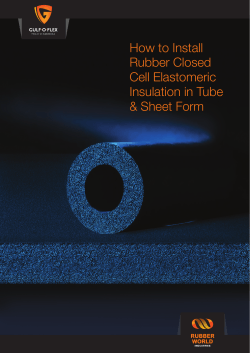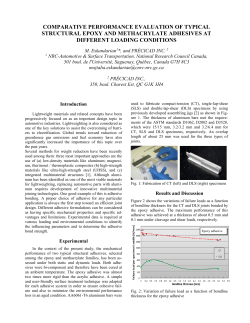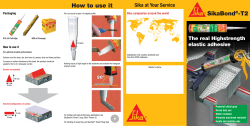
How to deal with cold weather variables Seasonal temperature changes will
FEBRUARY 2012 How to deal with cold weather variables By John Kohl A s the weather changes so does your starch adhesive. Colder temperatures in the plant during winter make it difficult to maintain the adhesive at optimum temperature for proper application to the flute tips and gelatinization during bonding. A box plant needs to be prepared for the colder temperatures and their starch adhesive supplier should be there to help with technical assistance. As temps come down, viscosity goes up As starch adhesive drops in temperature, its viscosity rises rapidly. For every 2oF drop in adhesive temperature there is a 10% increase in viscosity. The higher viscosity will cause too much starch to be carried on the glue roll and consequently applied to the flute tip. Also, the lower temperature adhesive needs more time to gel since it requires more temperature increase due to the lower starting point. This is compounded by excess application due to the higher viscosity. Colder street water, increased condensate Older starch mixing equipment doesn’t weigh the water or steam condensate added to the mixer during batch preparation. During the winter the incoming city water or treated waste water is much colder than normal so the plants also have to deal with viscosity changes due to the additional condensate from the steam used to heat the water. The storage tank’s TVC system needs to be in VISCOSITY IN STEIN HALL SECONDS Seasonal temperature changes will almost certainly require adjustments in your adhesive and procedures. We’ll help you sort it out. 70 65 60 55 As starch adhesive drops in temperature, its viscosity rises rapidly. For every 2oF drop in adhesive temperature there is a 10% increase in viscosity. 45 40 35 30 25 102 100 98 96 94 TEMPERATURE DEGREES FAHRENHEIT 92 90 good working order to keep the adhesive at the proper temperature and viscosity. The TVC coils inside the tanks need to be free of starch build up that acts as an insulator. Insulating starch supply and return lines will help maintain adhesive temperature, especially in the extremely cold climates. Colder air, colder paper Equipment issues such as colder incoming air for positive pressure single facers can cool off starch quickly causing viscosity to increase, causing bonding problems. Colder paper, from storing rolls outside or in an unheated warehouse, will make it more difficult to bond since the paper needs more heating than may be possible with available wrap arm configuration. Now is the time to make sure all of the machine’s heated rolls and traps are working properly, and transferring as much heat energy as possible, by checking their temperatures and making repairs where necessary. Cold air blowing into the plant from open doors from the outside or cold roll rooms can cause bonding problems as Next page, please Cold weather changes, cont’d well and exacerbate warp due to uneven temperatures across the web, so keep all the doors closed to minimize drafts. Monitor and test Monitoring adhesive viscosity and temperatures frequently in both storage tanks and pans will help identify any change that can cause application problems and poor bonding. The use of a soak tank and iodine stains can help identify glue roll pick up and transfer issues before warp and bonding make them apparent. All these issues with the starch adhesive and corrugator equipment are a direct result of colder weather lowering the temperature in the plant and the temperature of the incoming water, below the norm of the rest of the year. If you are already experiencing any of these issues or have not made winter formula adjustments, now is the time to have your starch adhesive supplier’s technical service representative adjust the formula accordingly and conduct a Since 1978, Harper/Love technical resources have helped progressive corrugating operations become more competitive through unprecidented heat audit to identify any equipment or process issues that productivity, superior quality and dramatically reduced waste. need to be addressed. Go with the flow Get a handle on adhesive viscosity By John Kohl V iscosity is the measure of a liquid’s resistance to flow. Stable viscosity is critical in corrugating adhesive if we expect it to deliver consistent performance. Starch-based corrugating adhesive is a liquid comprising 25% to 30% solids and 70% to 75% water. The way we make adhesive from corn starch, so it has a stable viscosity and is resistant to the loss of viscosity over time, is to completely cook out a portion of the starch. This cooked portion is referred to as the carrier starch since it keeps the raw starch in suspension for an extended period of time and carries the uncooked starch through the pipes and to the glue line for gelatinization by the heat on the corrugator. This is called the Stein Hall Method, and has been the basis for corrugating adhesive since the 1940s. The carrier portion of the adhesive is only 3% to 6% of the total adhesive but is the key to the Stein Hall process. Not only does it keep the uncooked starch in suspension, it The Stein Hall cup also controls the viscosity of the finished batch of adhesive. This is very evident on automatic high-shear starch mixers, where the amount of carrier is easily changed, and the resultant change in the finished batch viscosity is easily observed. There are two acceptable methods to measure the starch adhesive viscosity in a box plant: the Love cup or the Stein Hall cup. Both cups measure the adhesive flow through an orifice over time. The Love cup The Stein Hall cup should be preheated with the adhesive before the actual test is performed. It has a wall thickness of 3/16” solid brass that, if colder than the adhesive to be tested, will cool off the sample before the test is complete. This will give an inaccurate measurement. When filling the Stein Hall cup with adhesive, the adhesive should be strained through a kitchen strainer to remove any debris that could plug up the 1/10” hole the adhesive must pass through. The operator will measure the time the adhesive takes to drain out of the cup, starting at the top pin in the cup, and ending at the bottom pin. The resulting measurement should be recorded as seconds Stein Hall. Soak tank lessons The medium has a message, too By Bill Kahn O ne of the best analytical tools available in a corrugated plant is the soak tank. Its use allows us to observe a broad spectrum of machine and adhesive issues which can result in quality problems. In addition to light and heavy adhesive application, we can also discover tension issues, glue roll speed issues and numerous other defects. Too often we see operators soak the corrugated sheet apart and immediately discard the medium to focus their attention on the resultant glue lines on both liners. This is a mistake. That sheet of medium contains many valuable clues concerning the proper placement of the adhesive as well as the possibility of adhesive slinging (photo, left) which can be costly in terms of excess consumption as well as leading to unexplained warp problems. It can be a real eye-opener to use the iodine stain on the piece of medium and see the adhesive that has been delivered to the flank of the flutes or even to the valley of the flute. Remember that the adhesive is applied to the medium before it gets to the liner, so a thorough investigation should track the adhesive from the glue roll to the medium and then to the liner. The Love Cup has a wall thickness of only 1/16” so is less likely to cool the adhesive being tested. It also has an orifice that is 1/4” in diameter and is less likely to plug up with starch debris that could alter the viscosity reading. When measuring viscosity with a Love cup, fill the cup by completely submerging the cup in the adhesive. Start the timer when the cup is lifted out of the adhesive and stop the timer when the adhesive drains low enough to expose the crossbar in the bottom of the cup. Record the viscosity results in seconds Love cup. Since the drain orifice in the bottom of the cup is 2.5 times larger than the Stein Hall cup, the readings are approximately half that of Stein Hall. (Ask your Harper/Love rep for a conversion chart) Viscosity is sensitive to temperature change Whichever cup is used to measure the viscosity of the adhesive, it is important to check the temperature of the adhesive being tested and record it along with the viscosity, e.g., 24 seconds Love cup @ 1040F. Starch-based adhesive is very sensitive to temperature change. For every 20F change in its temperature, the adhesive viscosity measure in Stein Hall will change by 10% from the last reading. With an increase in temperature the viscosity drops; with a decrease in temperature the viscosity goes up. Variables that affect viscosity Starch adhesive storage tanks have a hot water circulating system, called a TVC (temperature and viscosity control) system, to keep the adhesive warm and minimize viscosity variations. The storage tank temperature can also be affected by the finished batch temperature, the returned starch from the corrugator pans, and ambient air temperature. All these variables need to be taken into account to keep the adhesive viscosity in an acceptable range for the corrugator. Adhesive viscosity and temperature should be checked and recorded for every batch made in a manual system, and at least twice per shift on an automatic system. The adhesive at the corrugator pans (or sumps) should also be checked twice per shift to ensure viscosity is in the ideal range for your machine. Other things that can greatly affect the adhesive viscosity include: wash-up water being sent back to the storage tanks, bacteria infestation in the storage tanks, and excessive mechanical shear from the transfer and supply pumps. Consistency is key The need for consistency in starch adhesive viscosity on the corrugator cannot be overemphasized. Viscosity is as important as the glue-roll gap setting for controlling the amount of adhesive that is transferred to the flute tips. If there is too much or too little adhesive applied to the flute tips you can experience warp or loose liner and delamination. All the variables mentioned, along with poor adhesive formulation, can alter the viscosity at the corrugator. The corrugator (and the board quality it produces) is only as good as the adhesive it is supplied with. This makes it important to work with your starch supplier to develop an ideal target range for the adhesive viscosity on you corrugator. There is no single viscosity for starch adhesive that will work for all box plants. The ideal viscosity depends on the machine, and may also be fine-tuned for different paper grades or product mixes. Whatever the viscosity target is in your plant, it needs to be monitored continuously to ensure the adhesive bond and overall board quality are the best possible. • Soak tank lessons • Measuring and controlling viscosity • Cold weather issues In this issue: 800-438-3066 • www.harperlove.com e-mail: salestech@harperlove.com Harper/Love Adhesives Corporation 11101 Westlake Drive P.O. Box 410408 Charlotte, NC 28241-0408 Leaders in the science of making good adhesives better™ You will never again outrun your adhesive First choice of our industry’s fastest corrugators MultiBondTM is a unique, fifth-generation performance enhancer. It provides higher speeds and improved bond on all grades of paper, including heavyweight, double wall, triple wall and hard-to-penetrate substrates. Because it takes less to get superior results, MultiBond is batch cost neutral, which means you pay no more to run with the best, and give up nothing in the Harper/Love service you’ve learned to rely on. To explore the technical and cost benefits MultiBond can provide your operation, contact your Harper/Love representative or call us toll free at 800-438-3066. Scan this QR code on your smart phone to view the MultiBond technical data sheet
© Copyright 2025









